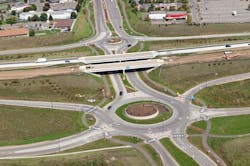Study shows roundabouts reduce traffic crashes in Minnesota
According to a new study released by the Minnesota Department of Transportation (MnDOT), the state’s nearly 200 roundabouts are reducing serious injuries and saving lives.
Minnesota built its first roundabout in 1995 in Brooklyn Park. Since then, MnDOT as well as the state’s counties and cities have built roundabouts across the state. These types of intersections have become increasingly popular by traffic engineers, communities and transportation officials. Roundabout types deployed in the state include single lanes, dual lanes and unbalanced lanes.
The new MnDOT’s roundabout study is the largest conducted in the state to date. Data from 144 individual sites were collected, including detailed information, by county and city, on each roundabout showing before and after installation crash rates and traffic volume. Sites with low traffic volumes and those that only service residential areas, small business parks or private settings were not studied.
The study examined the safety performance of roundabouts by comparing the before- and after-construction crash rates, and overall roundabouts are performing well. The study shows that there has not yet been a multi-vehicle fatality on a roundabout in Minnesota. There was an 86% reduction in the fatal crash rate at intersections where roundabouts were installed, and an 83% reduction in the serious injury crash rate.
The report also showed the following data at intersections with single-lane roundabouts (SLRs), the most common type of roundabout in the state, which showed a 69% reduction in right-angle crash rates; an 83% reduction in the left-turn crash rates; a 61% reduction in the injury crash rates; and for all roundabout types, there was a 42% reduction in the injury crash rates.
Design features of roundabouts that help reduce serious crashes and fatalities include yield control of entering traffic, and channelized approaches and other geometric elements that control travel speeds, facilitate efficient exchange of traffic flows, and minimize the number and severity of vehicle conflicts and crashes.
-----------
News & image source: Traffic Technology Today
